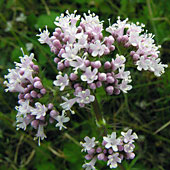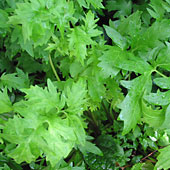Valerian
Keywords: all-heal, garden heliotrope, insomnia, anxiety, depression, headache


© Dr. Peter J. Llewellyn
On this page:
- Introduction
- What It Is Used For
- How It Is Used
- What the Science Says
- Side Effects and Cautions
- Sources
- For More Information
Introduction
This fact sheet provides basic information about the herbA plant or part of a plant used for its flavor, scent, or potential therapeutic properties. Includes flowers, leaves, bark, fruit, seeds, stems, and roots. valerian—common names, uses, potential side effects, and resources for more information. Valerian is a plant native to Europe and Asia; it is also found in North America. Valerian has been used as a medicinal herb since at least the time of ancient Greece and Rome. Its therapeutic uses were described by Hippocrates, and in the 2nd century, Galen prescribed valerian for insomnia.
Common Names—valerian, all-heal, garden heliotrope
Latin Names—Valeriana officinalis
What It Is Used For
- Valerian has long been used for sleep disorders and anxiety.
- Valerian has also been used for other conditions, such as headaches, depression, irregular heartbeat, and trembling.
How It Is Used
The roots and rhizomes (underground stems) of valerian are typically used to make supplements, including capsules, tablets, and liquid extracts, as well as teas.
What the Science Says
- Research suggests that valerian may be helpful for insomnia, but there is not enough evidence from well-designed studies to confirm this.
- There is not enough scientific evidence to determine whether valerian works for anxiety or for other conditions, such as depression and headaches.
- Recent NCCAM-funded research on valerian includes studies on the herb's effects on sleep in healthy older adults and in people with Parkinson's disease.
Side Effects and Cautions
- Studies suggest that valerian is generally safe to use for short periods of time (for example, 4 to 6 weeks).
- No information is available about the long-term safety of valerian.
- Valerian can cause mild side effects, such as headaches, dizziness, upset stomach, and tiredness the morning after its use.
- Tell your health care providers about any complementary and alternative practices you use. Give them a full picture of what you do to manage your health. This will help ensure coordinated and safe care.
Sources
- Office of Dietary Supplements and National Center for Complementary and Alternative Medicine. Questions and Answers About Valerian for Insomnia and Other Sleep Disorders. Office of Dietary Supplements Web site. Accessed July 10, 2007.
- Valerian. Natural Medicines Comprehensive Database Web site. Accessed July 5, 2007.
- Valerian (Valeriana officinalis L.). Natural Standard Database Web site. Accessed July 3, 2007.
- Valerian root (Valeriana officinalis). In: Blumenthal M, Goldberg A, Brinckman J, eds. Herbal Medicine: Expanded Commission E Monographs. Newton, MA: Lippincott Williams & Wilkins; 2000:394–400.
- Awang DVC, Leung AY. Valerian. In: Coates P, Blackman M, Cragg G, et al., eds. Encyclopedia of Dietary Supplements. New York, NY: Marcel Dekker; 2005:687–700.
For More Information
- What's in the Bottle? An Introduction to Dietary Supplements
- Herbal Supplements: Consider Safety, Too
NCCAM Clearinghouse
The NCCAM Clearinghouse provides information on CAM and NCCAM, including publications and searches of Federal databases of scientific and medical literature. The Clearinghouse does not provide medical advice, treatment recommendations, or referrals to practitioners.
Toll-free in the U.S.: 1-888-644-6226
TTY (for deaf and hard-of-hearing callers): 1-866-464-3615
Web site: nccam.nih.gov
E-mail:
CAM on PubMed
Web site: nccam.nih.gov/camonpubmed/
NIH Office of Dietary Supplements
Web site: ods.od.nih.gov
NIH National Library of Medicine's MedlinePlus
Valerian Listing: www.nlm.nih.gov/medlineplus/druginfo/natural/patient-valerian.html
This publication is not copyrighted and is in the public domain. Duplication is encouraged.
NCCAM Publication No. D272
Created May 2006
Updated June 2008
Note: PDF files requires a viewer such as the free Adobe Reader.
